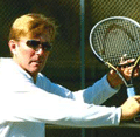The Overhead
Scott Murphy
Picture this: you hit a solid, deep approach shot off your opponent's short ball and you close on the net expecting to put away an easy volley. Instead, your opponent lobs.
You feel instant uneasiness as you attempt to maneuver into position. One thing's for sure though; you're going to blast this shot like there's no tomorrow.
The next thing you know you've: 1) hit it into the bottom of the net 2) drilled it off the back fence 3) miss hit it to God knows where 4) whiffed it completely. In any case, you're devastated because you've just blown a great opportunity to end the point with one of the most satisfying and devastating shots in the game, the overhead.
Sound familiar? Well don't feel alone. This scenario is played out over and over again on tennis courts around the world. Even Martina Navratilova once whiffed an overhead on Center Court at Wimbledon .
On the other hand, there are those players who routinely put away their overheads as if taking a walk in the park. (Certainly that was the case the vast majority of Martina's overheads.)
Why is that? It's been said that the overhead is the least practiced shot in the game. I'm inclined to agree. Therein lies the biggest difference between those who hit the overhead well and those that don't.
Why do so few players put legitimate practice time in on the overhead? I think the answer is simply that, while it's expected to be THE killer shot, it's just not that easy. (Imagine trying to hit your serve with a toss anywhere between 10 and 30 feet high that's all over the map).
A player's high expectations combined with minimal success can lead to reduced practice time. It's avoidance. The irony is that if this is the case for you constructive practice time is imperative.
You can put hour after hour into becoming a sensational volleyer, but once an opponent discovers you can't hit an overhead you can kiss your volley goodbye. So let's talk about what you can do to make your overhead a weapon instead of a liability.
Grip
The grip I recommend is the same for the serve and for the volley, the continental. If you're using the continental to volley, the first benefit is that you won't need to change your grip as you ready yourself to hit the overhead.
Ideally, the swing on an overhead is very similar to that of a serve and the continental makes that possible. You'll notice the similarities as we go along.
Preparation
The most important part of the preparation is the first step and the turn. For many players, the footwork will take care of itself if you simply think of turning sideways. The actual pattern of the steps is as follows. To initiate the turn, your left foot will unweight and then step to the inside. This is followed by the right foot stepping back, perpendicular to the net. As you do this, the hips and shoulders will also turn, ensuring the sideways position.
One of the most common errors in overhead preparation is to face the net and backpedal. That's a very instinctive move, but there are two big negatives associated with it.
The first is that when backpedaling you need to use very small steps to stay balanced. Unless the ball comes almost directly to you, this makes getting into position very tenuous. If you have to move back appreciably, it's difficult to cover the necessary distance to swing comfortably.
The second problem is that when you're facing the net, your body is in the way of the follow through. This forces you to slap or push the shot. If you try to hit with a full swing while facing the net, you could wind up smashing your left shin, and I guarantee if it ever happens you won't want to do it again. Ouch!
The simple solution is to turn and face the sideline as you take the first step back Once you're sideways, getting into position is much easier with either a series of slide steps or cross steps.
However, over the years I've found that dyed-in-the-wool backpedalers initially feel very uncomfortable turning sideways. Consciously or subconsciously they return to backpedaling in no time. As with all changes in your game, having a practice plan, focusing on the action and not the result, and really putting in the necessary practice time are absolutely essential.
The Nike Progressions
At the Nike Tahoe Tennis Camp we have a progression that helps simplify the transition required from the moment the lob goes up to the moment you hit the overhead.
|
|
the ball with the hitting arm. |
|
|
|
The player working on the overhead starts without a racket in the ready position, approximately midway between the net and the service line. A feeder on the other side of the net tosses a short lob that's more or less right above the other player. The player takes a step back, turns to face the sideline and reaches up to catch the ball with the non-hitting arm. This is repeated until the movements become comfortable. Next, the player does the same drill but with the hitting arm.
|
|
Now the player holds the racket at the throat. This time the player reaches up and taps the ball. As players become more adept, the height and depth of the tosses are increased until players can complete the progression from just about anywhere on the court.
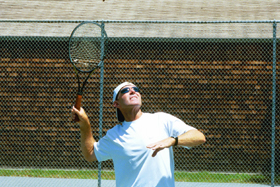
|
The Non Racket ArmIt's crucial that the non-racket arm should be fully extended just prior to hitting the ball. This is just like the tossing arm on a serve. Extending the non-racket arm helps you track the ball, keep your head up, and also contributes to the synchronization of the swing pattern. Some players are more comfortable immediately extending the non-hitting arm when the ball is lobbed. Others prefer initially to keep the non-hitting arm bent at the elbow at approximately shoulder height. There are 3 options with the non-racket arm: extending the arm immediately, keeping the elbow at shoulder height, and keeping the hand on the throat of the racket. |
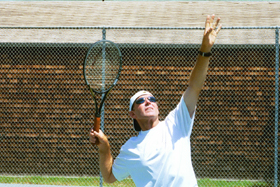
|
The great Stefan Edberg used a nice combination of both. As he turned sideways he kept the non-hitting hand on the throat of the racket, much like the early part of a forehand groundstroke coil. (This is a great way to insure the sideways turn). Then, just before he swung at the ball, he'd release the non-racket hand and fully extend that arm. Others players keep the non-hitting arm in dropped position, extending it much later. But these players have to be very adept at tracking the ball. I think that the player who uses either one of the last two methods feels they're able to see the ball better as they move into position The most common position of the hitting arm while tracking the ball is with the tip of the racket straight up and on edge. This is the classic trophy position associated with the serve. |
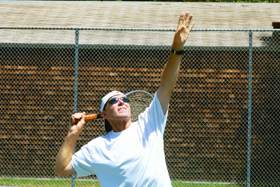
|
For some players however, starting with the racket this high creates a timing problem. For those players I suggest keeping the racket lower with the head basically parallel to the court, making sure to keep the wrist cocked. This will appreciably cut the time it takes to complete the swing. Some beginning players will also immediately put the racket in a dropped position to facilitate timing. You may have tried this at some point while working on acquiring the dropped position of the racket on your serve. I'm not saying this doesn't work for some, particularly in the early stages of development, but I think that in the long run it saps a player's rhythm, momentum, and makes it tough to develop "feel" for ball. |
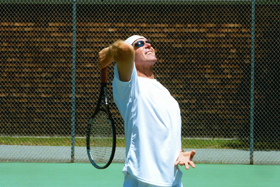
|
When you wait with the racket in the cocking position there are three more movements to execute the overhead. These are: the racket drop, the upward swing to the ball, and the follow through. The racket drop is one of the big power sources, so make sure your racket tip is pointing all the way down before you start upward to the ball. Once you decide to swing these movements should be continuous. It's extremely important to keep your head up until just AFTER you hit the ball. |
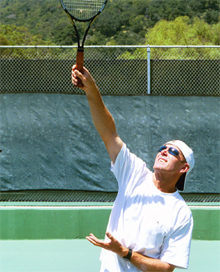
|
There's no question but that pulling the head down prematurely is one of the most common causes of inconsistency on the overhead. When I was a kid, my father would have me count "one" after I hit the overhead before I could look to see where it went and this works! When you swing, aim for the back of the ball and make sure you swing UP to it as if it was merely an object in the way of your touching the sky. Don't intentionally swing straight ahead or down. This will make the contact low and you'll either hit balls long or into the net. Your arm should be loose and relaxed and at the moment you strike the ball but also fully extended. |
|
Follow through on the overhead will depend on the difficulty factor. When you have good position and balance going in, your follow through should be just like that of a serve--down and across your opposite leg. If, however, you're not hitting a "cinch" overhead, the follow through may be minimal by comparison because your body position won't allow it. |
|
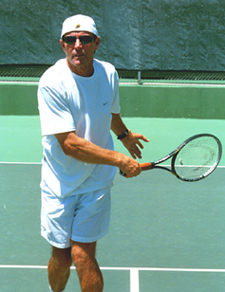
|
On the occasions when the ball that's lobbed toward you is exceptionally high, don't hesitate to let the ball bounce before you hit the overhead. Just remember that the need to swing "up" is still essential. If after the ball bounces it's too low to fully extend the arm and racket skyward, don't risk hitting an overhead. Sometimes by using your legs to get lower to a relatively low bounce you can still hit up, or modify the swing a bit by hitting with slice. The slice overhead is actually a good option when you're hitting from deep in your court and have a lot of court to play with on the other side. If for whatever reason you're already in the back court to receive a lob and you chose to hit an overhead off the bounce, make sure you provide an adequate amount of space between you and where the ball bounces. If you get too close the ball will carry back and over you. |
Court Position
It's also important not to fight your court position while hitting an overhead. A classic example of this is when a lob pulls a player (righty) towards the ad court alley.
If the player is still moving to his left when he hits, there's very little court to work with. It is very difficult to hit the ball down the line into the opponent's deuce court from this position. In addition, if the opponent is able to field the ball, he has a mile of open court to work with and can potentially hit an easy crosscourt forehand winner.
The best play here is to hit to the ad court where the angles to work with are far greater. You'll also have more time to recover and cover the angles in your own court. If you're playing another righty he'll likely have to play a running backhand which can also be much to your advantage.
For a great many players, the overhead becomes such a production that they're unable to get themselves ready for a reply should there be one. This is inevitable if it's a difficult ball, but one should always expect to play another ball.
This is particularly true in doubles where there are two people fielding the shot. There are players who are exceptional at anticipating and tracking down overheads. Sometimes you may have to hit as many as three or four overheads before the point's decided. Don't get discouraged if the first one wasn't a winner, as that will sap your ability to be ready for the next ball!
As much as the overhead is known for it's "thunderous" quality, it doesn't have to be hit hard to be effective. Please remember this! Unless you're supremely confident in your overhead, your intent to blast the shot can actually be causes you to miss! It's better to hit it well, with placement, trying to do something you're not capable of or simply don't need to do.
Specialty Overheads
There are some "specialty" overheads that you will invariably need to use. The first is called the scissor-kick. It gets its name from the scissoring action your legs make while hitting it. When the ball gets behind you, push off the back foot hit the ball while in the air, and land on the opposite foot. This is a very important shot to learn. It's inevitable that lobs will often demand it. Again, if you don't really practice this variation, you can't really expect to make it under pressure.
The skyhook isn't really an overhead per se, but a shot that keeps you in the point when you can't hit an overhead. This shot is necessary when the ball gets beyond the range of the scissor-kick. For those of you familiar with the hook shot in basketball it's virtually the same movement of the arm. With your arm and racket completely outstretched you move them in a semi-circular motion upward to the dropping ball. It's a last-ditch, defensive shot that usually winds up a lob, but it can be a point saver.
The backhand overhead or backhand smash is one of the prettiest shots in the game when hit well, but getting it to that point requires a lot of practice. Whenever there's time, do your best to move around it and hit a normal overhead, but when the lob is well disguised, or lower and faster, here's what you need to know.
Rotate to your backhand side to the extent that most of your back will be facing the net. You want to load up the shoulder so it will be tucked under your chin. Point your elbow up at the ball, thereby pointing the head of the racket down.
When you extend your arm up to meet the ball your body will counter rotate away from the ball. This is important because without it you risk "muscling" the shot and losing control of it in the process. By adjusting your wrist and forearm you can either angle the ball short and crosscourt or down the line. There's virtually no follow through-stop the racket at the point of contact.
Too many players practice their overheads while standing too far back from the net, and are therefore ill prepared to deal with the shot when they actually have to move to it. Don't make that mistake!
Once you feel pretty confident, practice while starting about halfway between the net and service line and have balls fed all over your court. Here are some specific overhead drills you can try.
Aerobic Overhead
Much like an outfielder fielding a fly ball, practice going back on lobs and simply positioning yourself in a way that you can reach up with the your non-racket arm and catch the ball slightly in front and a little to your hitting side. If you don't get to where you need to be, the most beautiful swing in the world won't do you any good!
Start in ideal volley position (halfway between the net and the service line). A feeder on the other side will say "go!" at which point you run up, touch the net with your racket, and move back to hit an overhead. Immediately thereafter you go back and touch the net and repeat around three to four times. This will be very aerobic!
Volley/Overhead
Starting again in ideal volley position a feeder on the opposite baseline gives you a ball to volley and then randomly lobs and groundstrokes while you hit volleys and overheads. For the sake of continuity you can hit a number of these back to the feeder and then at some point put the ball away. Practice reading the feeder's racket to improve your anticipation.
Lob/Overhead
Lastly, start in ideal volley position with another player at the opposite baseline. The baseliner starts a ball for you to volley back to him and from that point on he can only lob and you can only hit overheads. Overheads that are too deep or very high can be played off the bounce. If you simply can't hit an overhead, start the point over.
This game can also be very aerobic! When the overhead player wins the point it's worth one. When the baseliner wins it's worth two. Play to ten.
Summary
Don't be one of those players who constantly say, "I'll practice my overhead later." Just get in there and deal with it. To hit it well is a tremendous confidence builder - to hit it poorly can mean you'll wish you'd stayed in bed. And remember, when you're warming up for a match and your opponent declines to take overheads, when he gets to the net, LOB!
Special thanks to my long time student, former top Marin county junior player Tyler Hancock, for his help in demonstrating some of the drills for this article!



